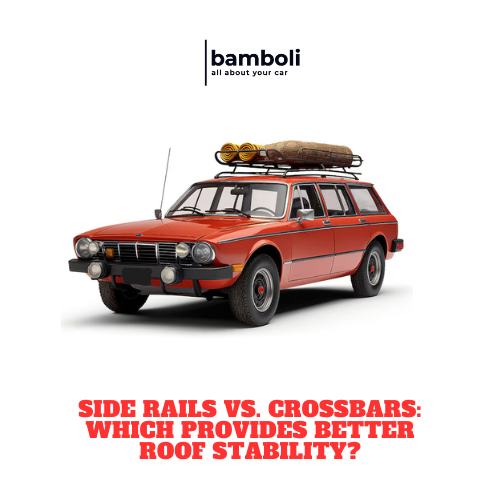Side Rails vs. Crossbars: Which Provides Better Roof Stability?

Side Rails vs. Crossbars: Which Provides Better Roof Stability?
Maximizing your vehicle's storage capacity often means utilizing the roof, especially for long trips or when transporting bulky items. Roof stability is crucial for safety and convenience, and the choice between side rails and crossbars can significantly impact this. In this article, we'll explore the functions, benefits, and drawbacks of both side rails and crossbars to help you decide which provides better roof stability for your vehicle.
Understanding the Basics
Side Rails
Side rails are mounted along the length of your vehicle’s roof, running from front to back. They serve as the foundation for attaching crossbars or other roof-mounted accessories.
Pros:
- Base Support: Side rails provide a solid foundation for installing crossbars, roof boxes, or other accessories.
- Aesthetic Integration: They are often designed to blend seamlessly with the vehicle’s design, enhancing its appearance.
- Versatility: Side rails can accommodate various configurations, making them adaptable for different needs.
Cons:
- Requires Crossbars: Side rails alone are not sufficient for carrying cargo; they need crossbars for load support.
- Installation: Some vehicles may not come with pre-installed side rails, requiring additional installation.
Crossbars
Crossbars are mounted perpendicular to the side rails, spanning the width of the roof. They provide direct support for cargo, roof boxes, and other roof-mounted equipment.
Pros:
- Direct Load Support: Crossbars directly support the load, providing a stable platform for carrying items.
- Flexibility: They can be adjusted and moved along the side rails to accommodate different load sizes and shapes.
- Compatibility: Crossbars are compatible with a wide range of accessories, from bike racks to cargo boxes.
Cons:
- Dependent on Side Rails: Crossbars need side rails for mounting; they cannot be used independently.
- Wind Resistance: Adding crossbars can increase wind resistance and potentially affect fuel efficiency.
Detailed Comparison: Side Rails vs. Crossbars
Stability and Support
|
Aspect |
Side Rails |
Crossbars |
|
Primary Function |
Serve as a mounting base for crossbars |
Directly support the load |
|
Stability Contribution |
Provide foundational stability |
Offer direct load stability |
|
Load Distribution |
Distribute weight along the roof length |
Distribute weight across the roof width |
Side rails offer foundational stability by distributing weight along the length of the vehicle’s roof. Crossbars enhance this stability by providing direct support across the width, ensuring a balanced load distribution.
Installation and Use
|
Aspect |
Side Rails |
Crossbars |
|
Installation |
May require professional installation if not pre-installed |
Usually easy to install if side rails are present |
|
Adjustability |
Fixed position along the vehicle length |
Adjustable along the side rails |
|
Usability |
Serve as a base for various configurations |
Essential for mounting roof accessories |
Side rails are often pre-installed on many vehicles, providing a ready foundation for crossbars. Crossbars, on the other hand, are adjustable and can be positioned according to the size and shape of the load.
Real-World Use Cases
Scenario 1: Family Road Trip
For a family road trip involving luggage, bicycles, and other gear, a combination of side rails and crossbars is ideal. Side rails provide the base stability, while crossbars offer the flexibility to mount various accessories securely.
Scenario 2: Outdoor Adventure
For outdoor adventures involving kayaks or canoes, crossbars are crucial. They provide the direct support needed to secure large, heavy items, ensuring they remain stable during transit.
Pros and Cons Recap
Side Rails
Pros:
- Provide a solid foundation for crossbars
- Enhance vehicle aesthetics
- Versatile for different configurations
Cons:
- Require crossbars for cargo support
- May need professional installation if not pre-installed
Crossbars
Pros:
- Directly support the load
- Adjustable for various load sizes and shapes
- Compatible with many roof accessories
Cons:
- Dependent on side rails for mounting
- Can increase wind resistance
Factors to Consider When Choosing
When deciding between side rails and crossbars, consider the following factors:
Vehicle Type
Your vehicle type will influence the choice. Many SUVs and wagons come with pre-installed side rails, making it easy to add crossbars. Smaller cars may not have side rails, requiring additional installation.
Load Requirements
Think about what you plan to carry. For heavy and large items like kayaks or roof boxes, crossbars are essential for direct support. Side rails alone cannot provide the necessary stability.
Frequency of Use
If you frequently use your roof for carrying various items, the flexibility and adjustability of crossbars will be beneficial. They allow you to adapt to different loads quickly.
Installation Tips
Installing Side Rails:
- Check Compatibility: Ensure the side rails are compatible with your vehicle model.
- Professional Help: If your vehicle does not have pre-installed side rails, consider professional installation for a secure fit.
- Secure Fitment: Make sure the side rails are tightly secured to avoid any movement.
Installing Crossbars:
- Positioning: Place the crossbars at appropriate distances along the side rails to balance the load.
- Secure Attachment: Use the provided clamps or bolts to secure the crossbars firmly.
- Weight Distribution: Evenly distribute the weight across the crossbars to maintain vehicle balance.
Maintenance Tips
For Side Rails:
- Regular Inspection: Check for any signs of wear or loose fittings regularly.
- Cleanliness: Keep the side rails clean to prevent rust and corrosion.
For Crossbars:
- Tightness Check: Ensure the crossbars remain tightly secured, especially before long trips.
- Clean Regularly: Clean the crossbars to prevent buildup of dirt and debris.
Frequently Asked Questions
Can I use side rails without crossbars? Side rails alone are not suitable for directly carrying loads. They are designed to serve as a base for crossbars or other accessories.
Are crossbars universal? While many crossbars are adjustable and compatible with various side rails, it's important to check compatibility with your specific vehicle model.
Do side rails affect fuel efficiency? Side rails have a minimal impact on fuel efficiency. However, adding crossbars and loaded roof racks can increase wind resistance, slightly affecting fuel efficiency.
Can I install crossbars myself? Yes, if your vehicle has pre-installed side rails, installing crossbars is typically straightforward. Follow the manufacturer’s instructions for the best results.
How do I choose the right crossbars? Choose crossbars based on your vehicle’s side rails, the type of load you plan to carry, and any specific accessory requirements (e.g., bike racks, cargo boxes).
Choosing the Right Option for Your Vehicle
Ultimately, the choice between side rails and crossbars depends on your specific needs and vehicle type. Side rails provide foundational stability and aesthetic integration, making them ideal for vehicles that need a base for various roof-mounted accessories. Crossbars offer direct load support and flexibility, essential for carrying heavy or large items securely.
Consider your typical usage scenarios, vehicle specifications, and the type of loads you intend to carry to make an informed decision. Both side rails and crossbars have unique advantages, ensuring your vehicle’s roof stability and enhancing its carrying capacity.




